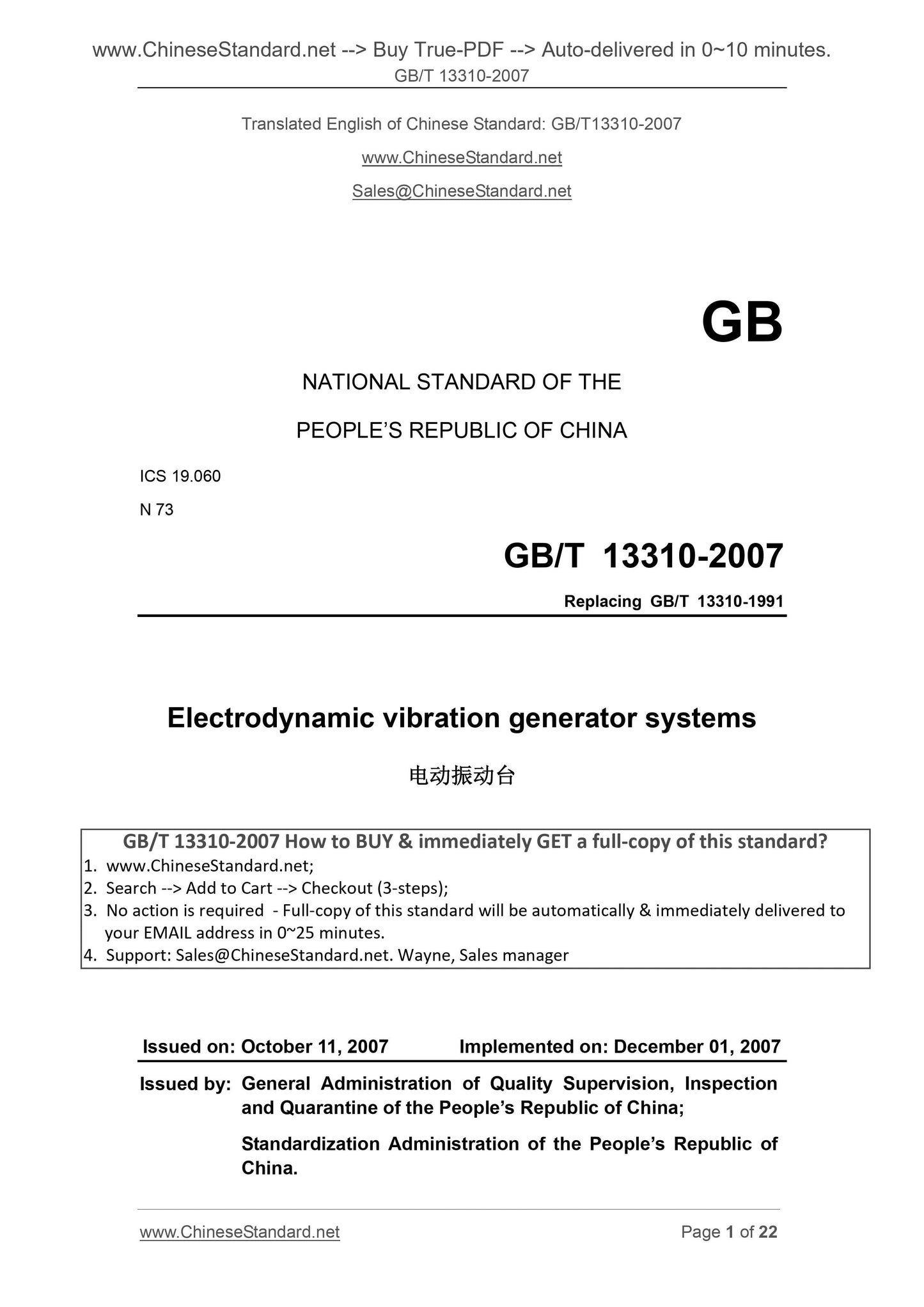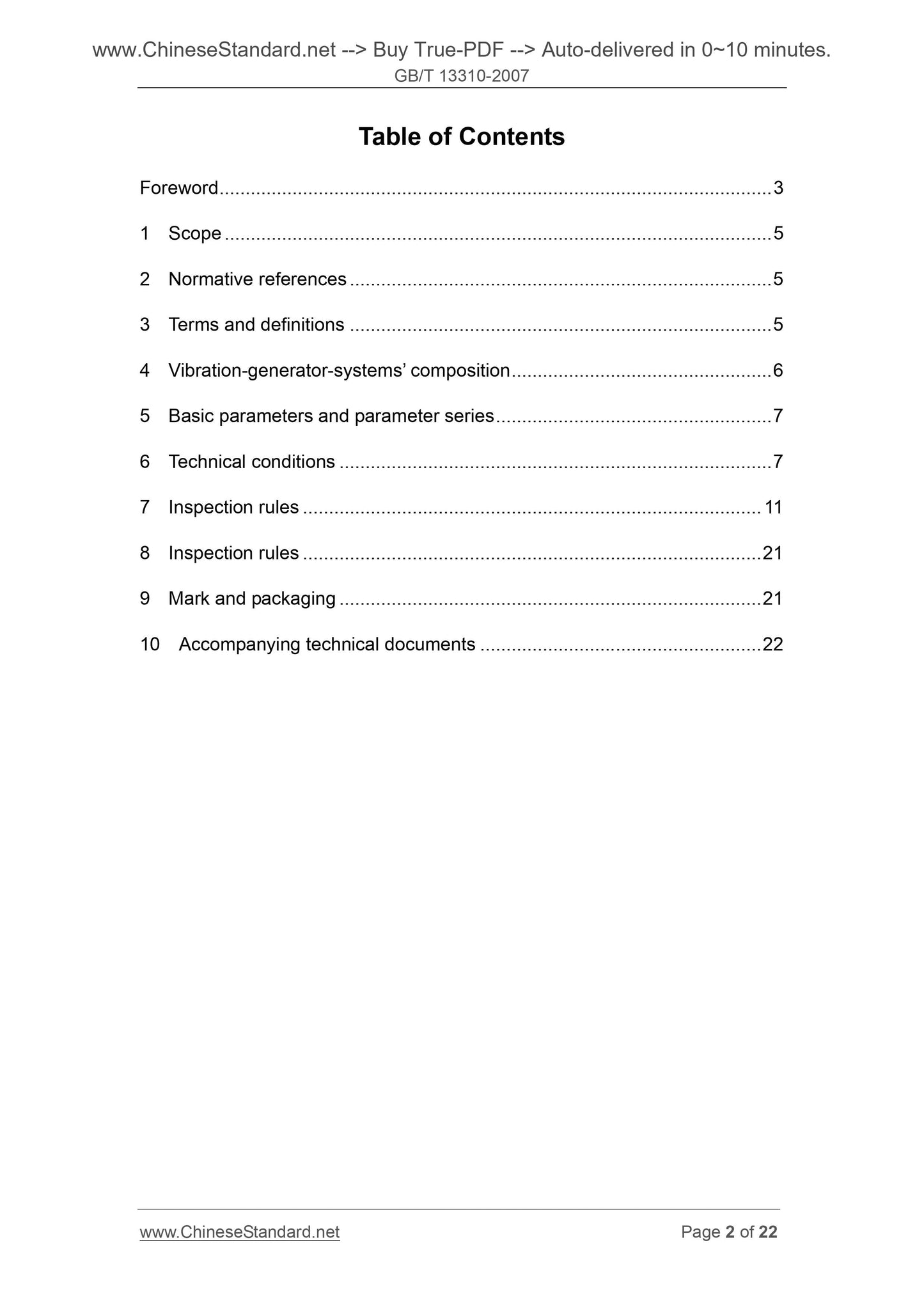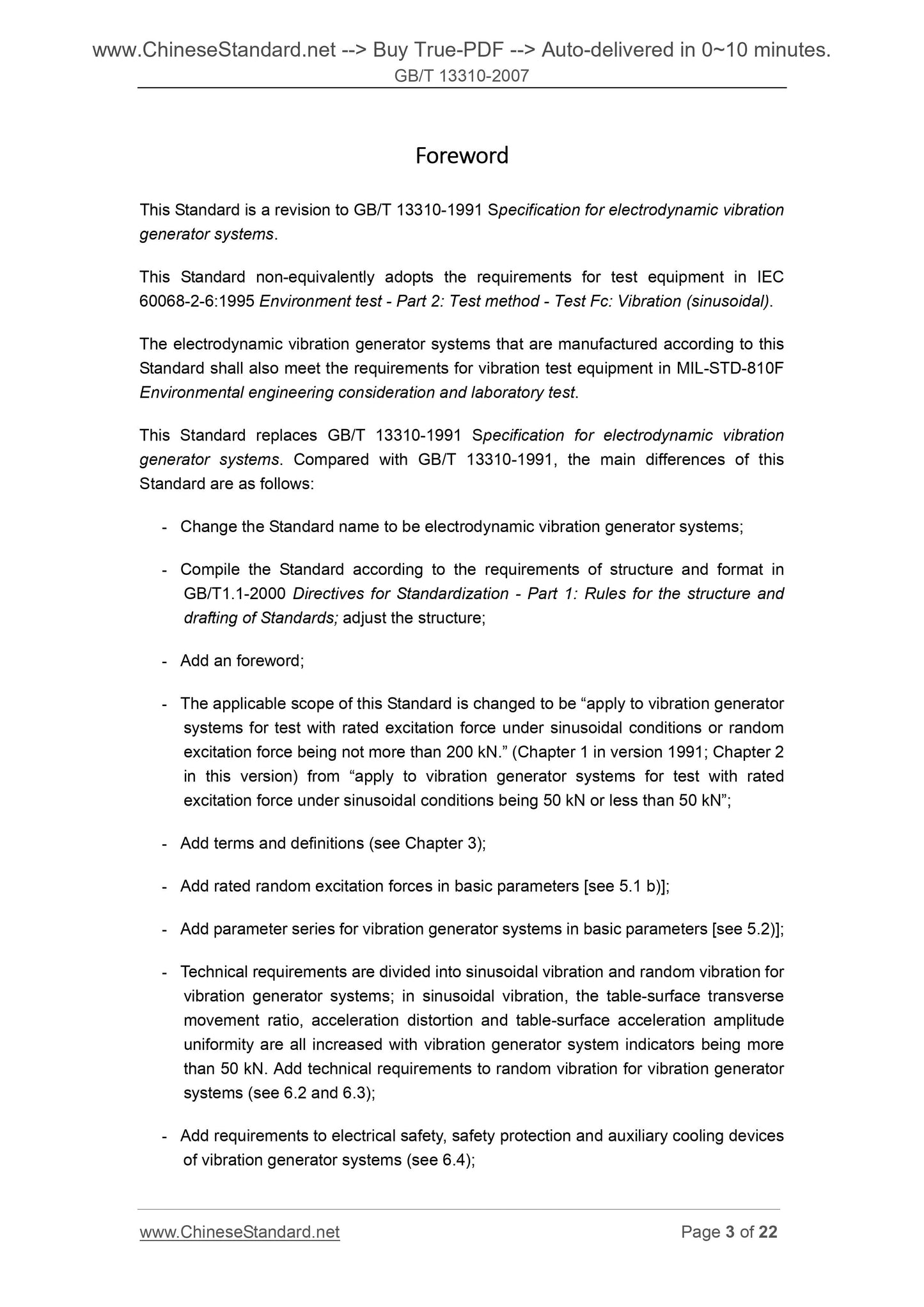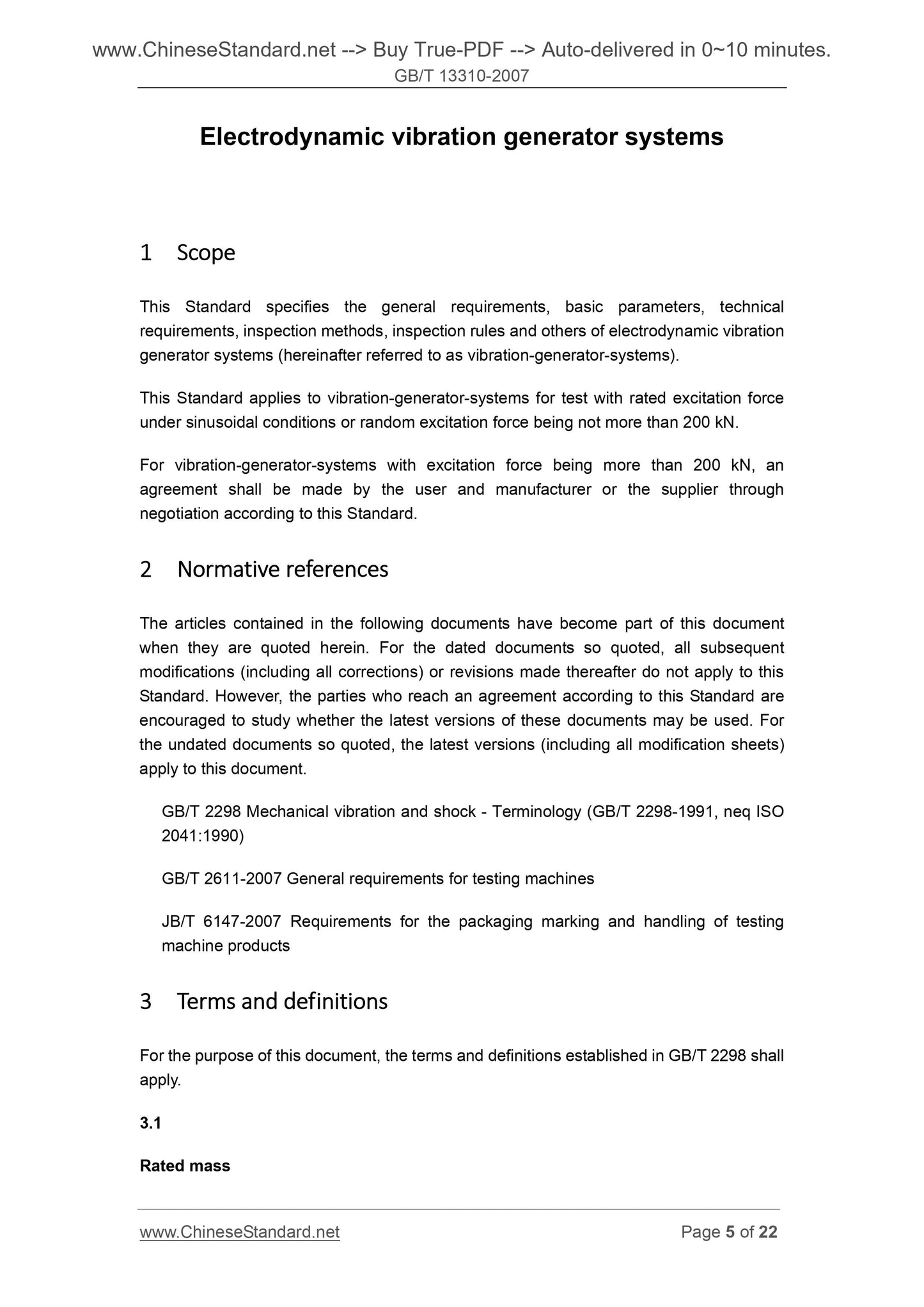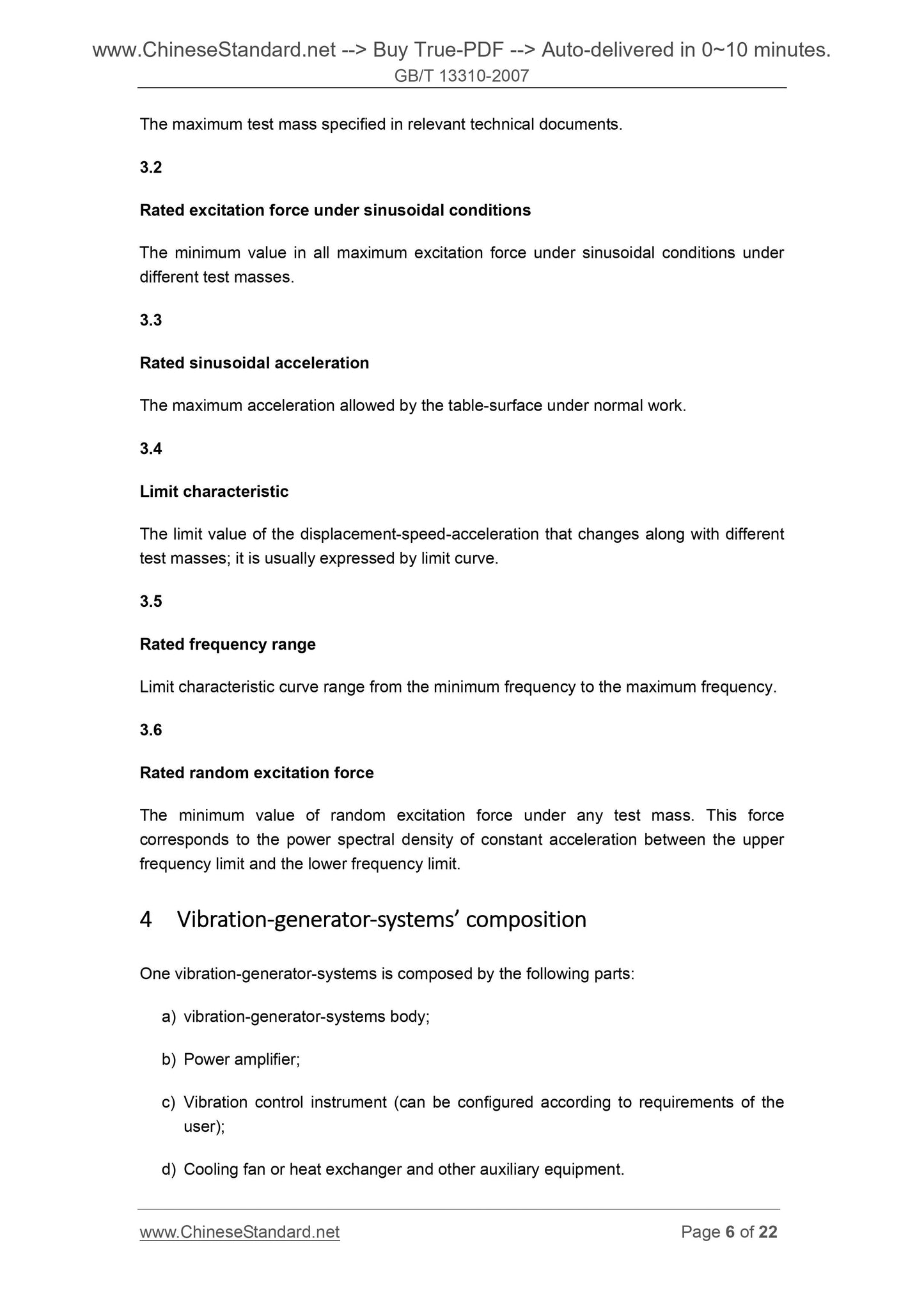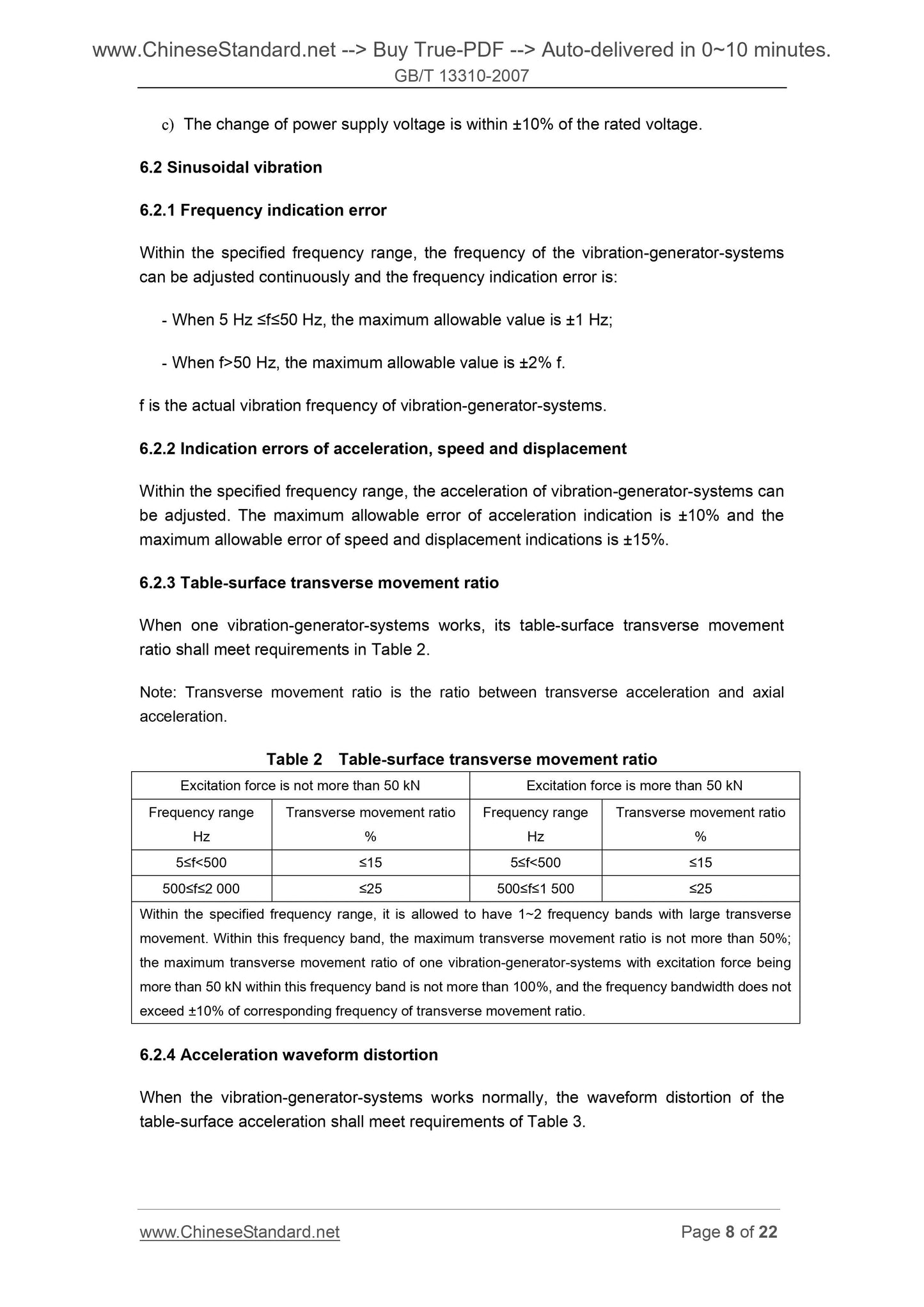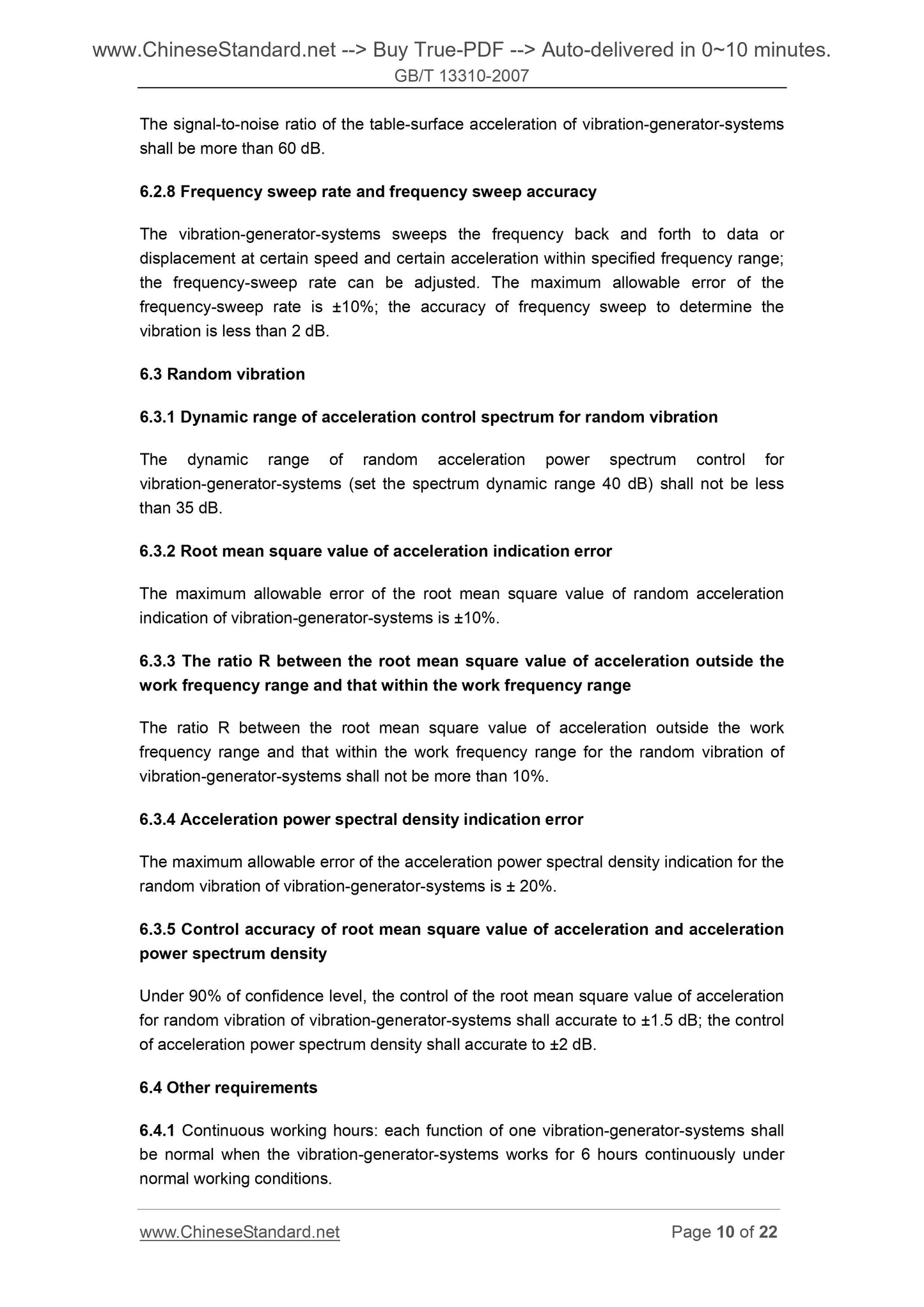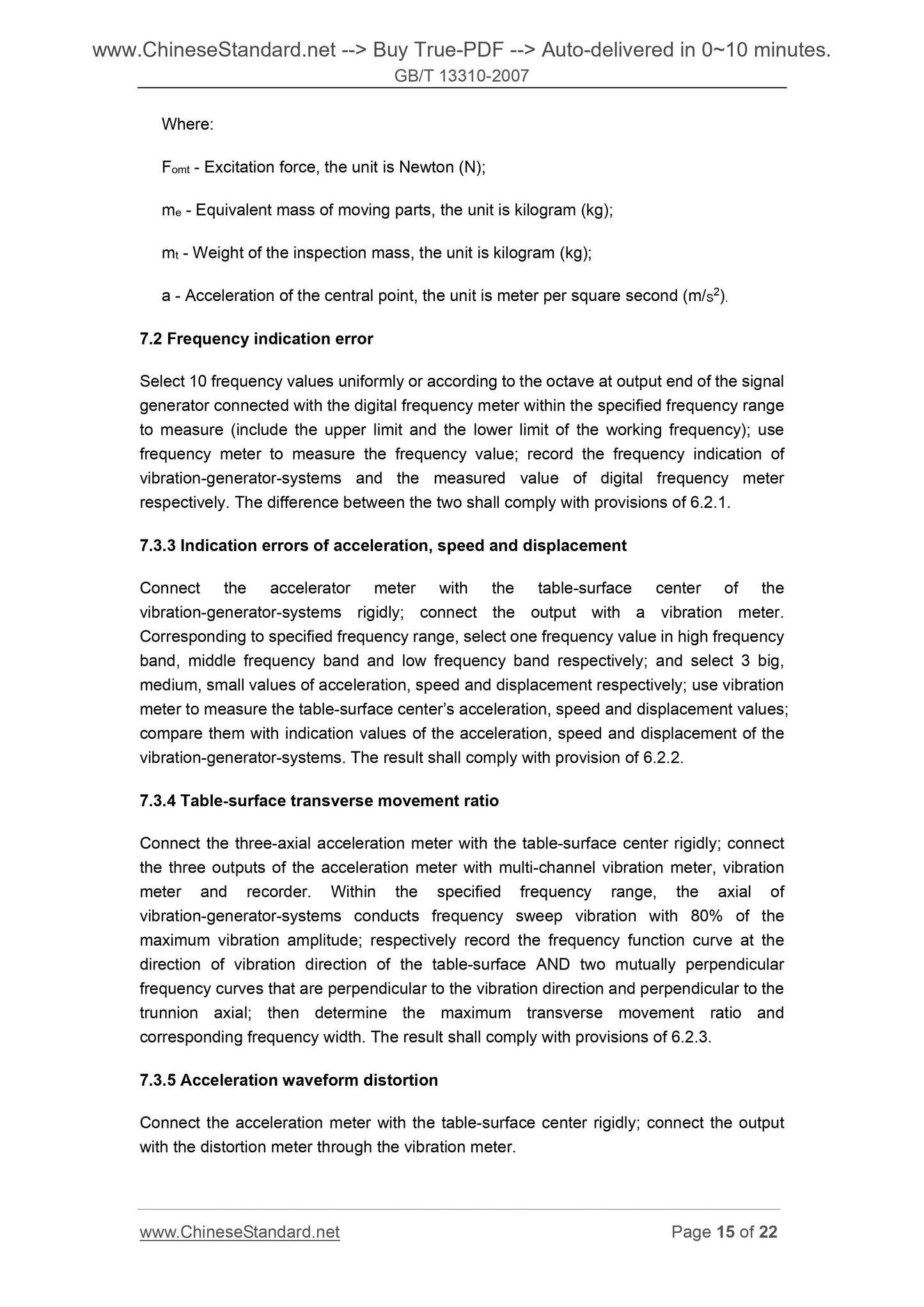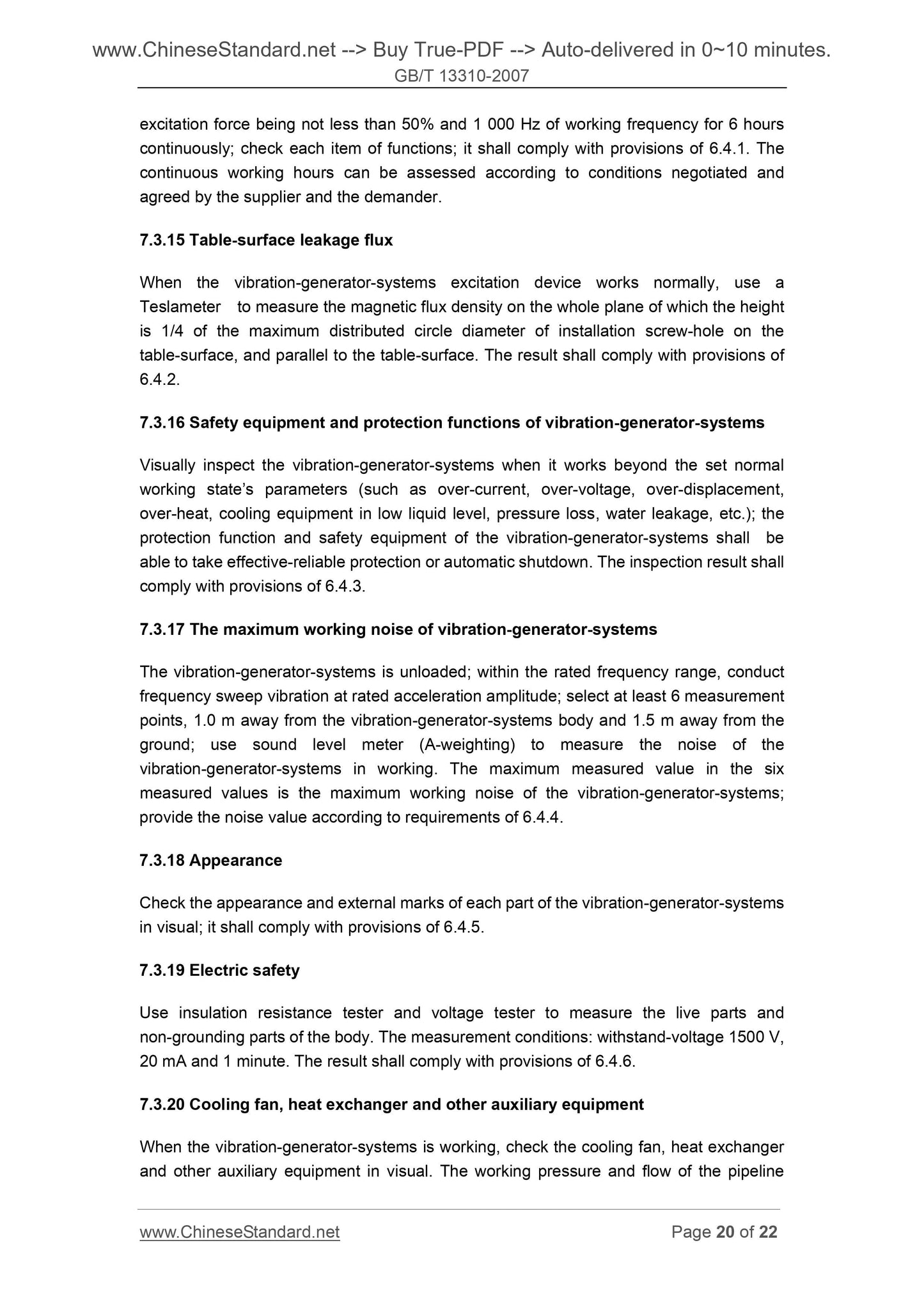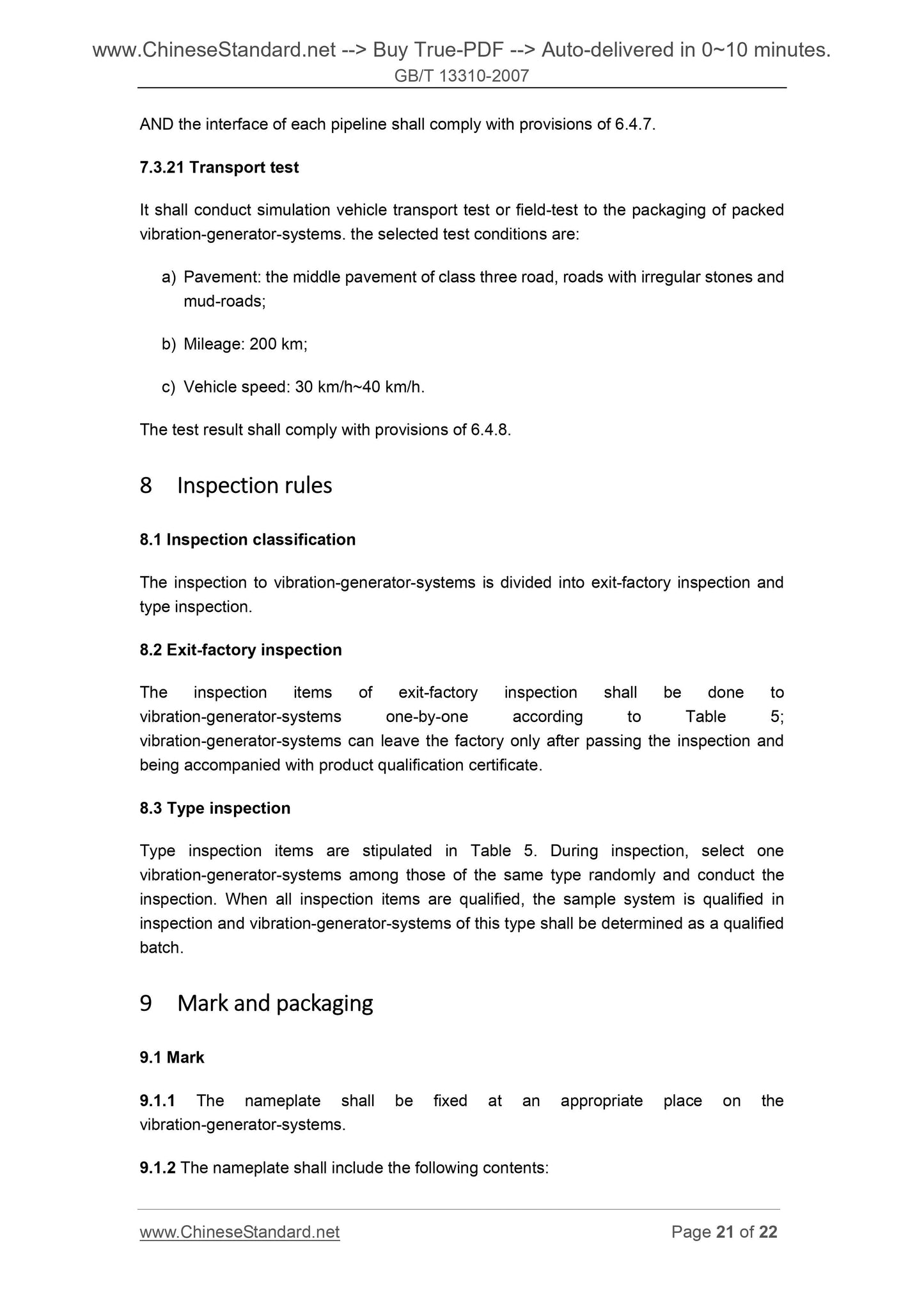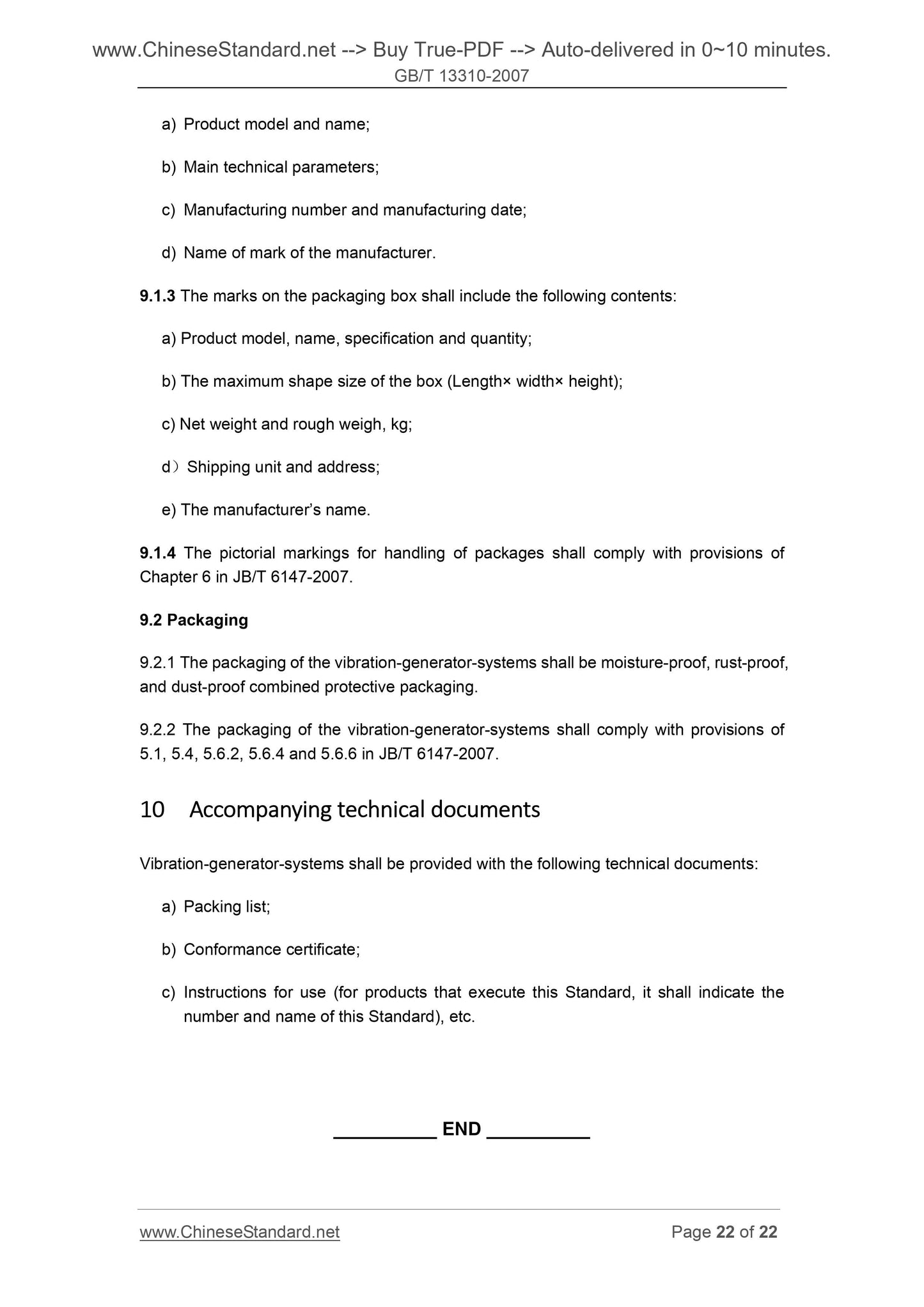1
/
of
12
www.ChineseStandard.us -- Field Test Asia Pte. Ltd.
GB/T 13310-2007 English PDF (GB/T13310-2007)
GB/T 13310-2007 English PDF (GB/T13310-2007)
Regular price
$140.00
Regular price
Sale price
$140.00
Unit price
/
per
Shipping calculated at checkout.
Couldn't load pickup availability
GB/T 13310-2007: Electrodynamic vibration generator systems
Delivery: 9 seconds. Download (& Email) true-PDF + Invoice.
Get Quotation: Click GB/T 13310-2007 (Self-service in 1-minute)
Historical versions (Master-website): GB/T 13310-2007
Preview True-PDF (Reload/Scroll-down if blank)
GB/T 13310-2007
GB
NATIONAL STANDARD OF THE
PEOPLE’S REPUBLIC OF CHINA
ICS 19.060
N 73
Replacing GB/T 13310-1991
Electrodynamic vibration generator systems
ISSUED ON. OCTOBER 11, 2007
IMPLEMENTED ON. DECEMBER 01, 2007
Issued by.
General Administration of Quality Supervision, Inspection
and Quarantine of the People’s Republic of China;
Standardization Administration of the People’s Republic of
China.
Table of Contents
Foreword ... 3
1 Scope ... 5
2 Normative references ... 5
3 Terms and definitions ... 5
4 Vibration-generator-systems’ composition ... 6
5 Basic parameters and parameter series ... 7
6 Technical conditions ... 7
7 Inspection rules ... 11
8 Inspection rules ... 21
9 Mark and packaging ... 21
10 Accompanying technical documents ... 22
Foreword
This Standard is a revision to GB/T 13310-1991 Specification for electrodynamic vibration
generator systems.
This Standard non-equivalently adopts the requirements for test equipment in IEC
60068-2-6.1995 Environment test - Part 2. Test method - Test Fc. Vibration (sinusoidal).
The electrodynamic vibration generator systems that are manufactured according to this
Standard shall also meet the requirements for vibration test equipment in MIL-STD-810F
Environmental engineering consideration and laboratory test.
This Standard replaces GB/T 13310-1991 Specification for electrodynamic vibration
generator systems. Compared with GB/T 13310-1991, the main differences of this
Standard are as follows.
- Change the Standard name to be electrodynamic vibration generator systems;
- Compile the Standard according to the requirements of structure and format in
GB/T1.1-2000 Directives for Standardization - Part 1. Rules for the structure and
drafting of Standards; adjust the structure;
- Add an foreword;
- The applicable scope of this Standard is changed to be “apply to vibration generator
systems for test with rated excitation force under sinusoidal conditions or random
excitation force being not more than 200 kN.” (Chapter 1 in version 1991; Chapter 2
in this version) from “apply to vibration generator systems for test with rated
excitation force under sinusoidal conditions being 50 kN or less than 50 kN”;
- Add terms and definitions (see Chapter 3);
- Add rated random excitation forces in basic parameters [see 5.1 b)];
- Add parameter series for vibration generator systems in basic parameters [see 5.2)];
- Technical requirements are divided into sinusoidal vibration and random vibration for
vibration generator systems; in sinusoidal vibration, the table-surface transverse
movement ratio, acceleration distortion and table-surface acceleration amplitude
uniformity are all increased with vibration generator system indicators being more
than 50 kN. Add technical requirements to random vibration for vibration generator
systems (see 6.2 and 6.3);
- Add requirements to electrical safety, safety protection and auxiliary cooling devices
of vibration generator systems (see 6.4);
Electrodynamic vibration generator systems
1 Scope
This Standard specifies the general requirements, basic parameters, technical
requirements, inspection methods, inspection rules and others of electrodynamic vibration
generator systems (hereinafter referred to as vibration-generator-systems).
This Standard applies to vibration-generator-systems for test with rated excitation force
under sinusoidal conditions or random excitation force being not more than 200 kN.
For vibration-generator-systems with excitation force being more than 200 kN, an
agreement shall be made by the user and manufacturer or the supplier through
negotiation according to this Standard.
2 Normative references
The articles contained in the following documents have become part of this document
when they are quoted herein. For the dated documents so quoted, all subsequent
modifications (including all corrections) or revisions made thereafter do not apply to this
Standard. However, the parties who reach an agreement according to this Standard are
encouraged to study whether the latest versions of these documents may be used. For
the undated documents so quoted, the latest versions (including all modification sheets)
apply to this document.
GB/T 2298 Mechanical vibration and shock - Terminology (GB/T 2298-1991, neq ISO
2041.1990)
GB/T 2611-2007 General requirements for testing machines
JB/T 6147-2007 Requirements for the packaging marking and handling of testing
machine products
3 Terms and definitions
For the purpose of this document, the terms and definitions established in GB/T 2298 shall
apply.
3.1
Rated mass
The maximum test mass specified in relevant technical documents.
3.2
Rated excitation force under sinusoidal conditions
The minimum value in all maximum excitation force under sinusoidal conditions under
different test masses.
3.3
Rated sinusoidal acceleration
The maximum acceleration allowed by the table-surface under normal work.
3.4
Limit characteristic
The limit value of the displacement-speed-acceleration that changes along with different
test masses; it is usually expressed by limit curve.
3.5
Rated frequency range
Limit characteristic curve range from the minimum frequency to the maximum frequency.
3.6
Rated random excitation force
The minimum value of random excitation force under any test mass. This force
corresponds to the power spectral density of constant acceleration between the upper
frequency limit and the lower frequency limit.
4 Vibration‐generator‐systems’ composition
One vibration-generator-systems is composed by the following parts.
a) vibration-generator-systems body;
b) Power amplifier;
c) Vibration control instrument (can be configured according to requirements of the
user);
d) Cooling fan or heat exchanger and other auxiliary equipment.
c) The change of power supply voltage is within ±10% of the rated voltage.
6.2 Sinusoidal vibration
6.2.1 Frequency indication error
Within the specified frequency range, the frequency of the vibration-generator-systems
can be adjusted continuously and the frequency indication error is.
- When 5 Hz ≤f≤50 Hz, the maximum allowable value is ±1 Hz;
- When f>50 Hz, the maximum allowable value is ±2% f.
f is the actual vibration frequency of vibration-generator-systems.
6.2.2 Indication errors of acceleration, speed and displacement
Within the specified frequency range, the acceleration of vibration-generator-systems can
be adjusted. The maximum allowable error of acceleration indication is ±10% and the
maximum allowable error of speed and displacement indications is ±15%.
6.2.3 Table-surface transverse movement ratio
When one vibration-generator-systems works, its table-surface transverse movement
ratio shall meet requirements in Table 2.
Note. Transverse movement ratio is the ratio between transverse acceleration and axial
acceleration.
Table 2 Table-surface transverse movement ratio
Excitation force is not more than 50 kN Excitation force is more than 50 kN
Frequency range
Hz
Transverse movement ratio
Frequency range
Hz
Transverse movement ratio
5≤f< 500 ≤15 5≤f< 500 ≤15
500≤f≤2 000 ≤25 500≤f≤1 500 ≤25
Within the specified frequency range, it is allowed to have 1~2 frequency bands with large transverse
movement. Within this frequency band, the maximum transverse movement ratio is not more than 50%;
the maximum transverse movement ratio of one vibration-generator-systems with excitation force being
more than 50 kN within this frequency band is not more than 100%, and the frequency bandwidth does not
exceed ±10% of corresponding frequency of transverse movement ratio.
6.2.4 Acceleration waveform distortion
When the vibration-generator-systems works normally, the waveform distortion of the
table-surface acceleration shall meet requirements of Table 3.
The signal-to-noise ratio of the table-surface acceleration of vibration-generator-systems
shall be more than 60 dB.
6.2.8 Frequency sweep rate and frequency sweep accuracy
The vibration-generator-systems sweeps the frequency back and forth to data or
displacement at certain speed and certain acceleration within specified frequency range;
the frequency-sweep rate can be adjusted. The maximum allowable error of the
frequency-sweep rate is ±10%; the accuracy of frequency sweep to determine the
vibration is less than 2 dB.
6.3 Random vibration
6.3.1 Dynamic range of acceleration control spectrum for random vibration
The dynamic range of random acceleration power spectrum control for
vibration-generator-systems (set the spectrum dynamic range 40 dB) shall not be less
than 35 dB.
6.3.2 Root mean square value of acceleration indication error
The maximum allowable error of the root mean square value of random acceleration
indication of vibration-generator-systems is ±10%.
6.3.3 The ratio R between the root mean square value of acceleration outside the
work frequency...
GB/T 13310-2007
GB
NATIONAL STANDARD OF THE
PEOPLE’S REPUBLIC OF CHINA
ICS 19.060
N 73
Replacing GB/T 13310-1991
Electrodynamic vibration generator systems
ISSUED ON. OCTOBER 11, 2007
IMPLEMENTED ON. DECEMBER 01, 2007
Issued by.
General Administration of Quality Supervision, Inspection
and Quarantine of the People’s Republic of China;
Standardization Administration of the People’s Republic of
China.
Table of Contents
Foreword ... 3
1 Scope ... 5
2 Normative references ... 5
3 Terms and definitions ... 5
4 Vibration-generator-systems’ composition ... 6
5 Basic parameters and parameter series ... 7
6 Technical conditions ... 7
7 Inspection rules ... 11
8 Inspection rules ... 21
9 Mark and packaging ... 21
10 Accompanying technical documents ... 22
Foreword
This Standard is a revision to GB/T 13310-1991 Specification for electrodynamic vibration
generator systems.
This Standard non-equivalently adopts the requirements for test equipment in IEC
60068-2-6.1995 Environment test - Part 2. Test method - Test Fc. Vibration (sinusoidal).
The electrodynamic vibration generator systems that are manufactured according to this
Standard shall also meet the requirements for vibration test equipment in MIL-STD-810F
Environmental engineering consideration and laboratory test.
This Standard replaces GB/T 13310-1991 Specification for electrodynamic vibration
generator systems. Compared with GB/T 13310-1991, the main differences of this
Standard are as follows.
- Change the Standard name to be electrodynamic vibration generator systems;
- Compile the Standard according to the requirements of structure and format in
GB/T1.1-2000 Directives for Standardization - Part 1. Rules for the structure and
drafting of Standards; adjust the structure;
- Add an foreword;
- The applicable scope of this Standard is changed to be “apply to vibration generator
systems for test with rated excitation force under sinusoidal conditions or random
excitation force being not more than 200 kN.” (Chapter 1 in version 1991; Chapter 2
in this version) from “apply to vibration generator systems for test with rated
excitation force under sinusoidal conditions being 50 kN or less than 50 kN”;
- Add terms and definitions (see Chapter 3);
- Add rated random excitation forces in basic parameters [see 5.1 b)];
- Add parameter series for vibration generator systems in basic parameters [see 5.2)];
- Technical requirements are divided into sinusoidal vibration and random vibration for
vibration generator systems; in sinusoidal vibration, the table-surface transverse
movement ratio, acceleration distortion and table-surface acceleration amplitude
uniformity are all increased with vibration generator system indicators being more
than 50 kN. Add technical requirements to random vibration for vibration generator
systems (see 6.2 and 6.3);
- Add requirements to electrical safety, safety protection and auxiliary cooling devices
of vibration generator systems (see 6.4);
Electrodynamic vibration generator systems
1 Scope
This Standard specifies the general requirements, basic parameters, technical
requirements, inspection methods, inspection rules and others of electrodynamic vibration
generator systems (hereinafter referred to as vibration-generator-systems).
This Standard applies to vibration-generator-systems for test with rated excitation force
under sinusoidal conditions or random excitation force being not more than 200 kN.
For vibration-generator-systems with excitation force being more than 200 kN, an
agreement shall be made by the user and manufacturer or the supplier through
negotiation according to this Standard.
2 Normative references
The articles contained in the following documents have become part of this document
when they are quoted herein. For the dated documents so quoted, all subsequent
modifications (including all corrections) or revisions made thereafter do not apply to this
Standard. However, the parties who reach an agreement according to this Standard are
encouraged to study whether the latest versions of these documents may be used. For
the undated documents so quoted, the latest versions (including all modification sheets)
apply to this document.
GB/T 2298 Mechanical vibration and shock - Terminology (GB/T 2298-1991, neq ISO
2041.1990)
GB/T 2611-2007 General requirements for testing machines
JB/T 6147-2007 Requirements for the packaging marking and handling of testing
machine products
3 Terms and definitions
For the purpose of this document, the terms and definitions established in GB/T 2298 shall
apply.
3.1
Rated mass
The maximum test mass specified in relevant technical documents.
3.2
Rated excitation force under sinusoidal conditions
The minimum value in all maximum excitation force under sinusoidal conditions under
different test masses.
3.3
Rated sinusoidal acceleration
The...
Delivery: 9 seconds. Download (& Email) true-PDF + Invoice.
Get Quotation: Click GB/T 13310-2007 (Self-service in 1-minute)
Historical versions (Master-website): GB/T 13310-2007
Preview True-PDF (Reload/Scroll-down if blank)
GB/T 13310-2007
GB
NATIONAL STANDARD OF THE
PEOPLE’S REPUBLIC OF CHINA
ICS 19.060
N 73
Replacing GB/T 13310-1991
Electrodynamic vibration generator systems
ISSUED ON. OCTOBER 11, 2007
IMPLEMENTED ON. DECEMBER 01, 2007
Issued by.
General Administration of Quality Supervision, Inspection
and Quarantine of the People’s Republic of China;
Standardization Administration of the People’s Republic of
China.
Table of Contents
Foreword ... 3
1 Scope ... 5
2 Normative references ... 5
3 Terms and definitions ... 5
4 Vibration-generator-systems’ composition ... 6
5 Basic parameters and parameter series ... 7
6 Technical conditions ... 7
7 Inspection rules ... 11
8 Inspection rules ... 21
9 Mark and packaging ... 21
10 Accompanying technical documents ... 22
Foreword
This Standard is a revision to GB/T 13310-1991 Specification for electrodynamic vibration
generator systems.
This Standard non-equivalently adopts the requirements for test equipment in IEC
60068-2-6.1995 Environment test - Part 2. Test method - Test Fc. Vibration (sinusoidal).
The electrodynamic vibration generator systems that are manufactured according to this
Standard shall also meet the requirements for vibration test equipment in MIL-STD-810F
Environmental engineering consideration and laboratory test.
This Standard replaces GB/T 13310-1991 Specification for electrodynamic vibration
generator systems. Compared with GB/T 13310-1991, the main differences of this
Standard are as follows.
- Change the Standard name to be electrodynamic vibration generator systems;
- Compile the Standard according to the requirements of structure and format in
GB/T1.1-2000 Directives for Standardization - Part 1. Rules for the structure and
drafting of Standards; adjust the structure;
- Add an foreword;
- The applicable scope of this Standard is changed to be “apply to vibration generator
systems for test with rated excitation force under sinusoidal conditions or random
excitation force being not more than 200 kN.” (Chapter 1 in version 1991; Chapter 2
in this version) from “apply to vibration generator systems for test with rated
excitation force under sinusoidal conditions being 50 kN or less than 50 kN”;
- Add terms and definitions (see Chapter 3);
- Add rated random excitation forces in basic parameters [see 5.1 b)];
- Add parameter series for vibration generator systems in basic parameters [see 5.2)];
- Technical requirements are divided into sinusoidal vibration and random vibration for
vibration generator systems; in sinusoidal vibration, the table-surface transverse
movement ratio, acceleration distortion and table-surface acceleration amplitude
uniformity are all increased with vibration generator system indicators being more
than 50 kN. Add technical requirements to random vibration for vibration generator
systems (see 6.2 and 6.3);
- Add requirements to electrical safety, safety protection and auxiliary cooling devices
of vibration generator systems (see 6.4);
Electrodynamic vibration generator systems
1 Scope
This Standard specifies the general requirements, basic parameters, technical
requirements, inspection methods, inspection rules and others of electrodynamic vibration
generator systems (hereinafter referred to as vibration-generator-systems).
This Standard applies to vibration-generator-systems for test with rated excitation force
under sinusoidal conditions or random excitation force being not more than 200 kN.
For vibration-generator-systems with excitation force being more than 200 kN, an
agreement shall be made by the user and manufacturer or the supplier through
negotiation according to this Standard.
2 Normative references
The articles contained in the following documents have become part of this document
when they are quoted herein. For the dated documents so quoted, all subsequent
modifications (including all corrections) or revisions made thereafter do not apply to this
Standard. However, the parties who reach an agreement according to this Standard are
encouraged to study whether the latest versions of these documents may be used. For
the undated documents so quoted, the latest versions (including all modification sheets)
apply to this document.
GB/T 2298 Mechanical vibration and shock - Terminology (GB/T 2298-1991, neq ISO
2041.1990)
GB/T 2611-2007 General requirements for testing machines
JB/T 6147-2007 Requirements for the packaging marking and handling of testing
machine products
3 Terms and definitions
For the purpose of this document, the terms and definitions established in GB/T 2298 shall
apply.
3.1
Rated mass
The maximum test mass specified in relevant technical documents.
3.2
Rated excitation force under sinusoidal conditions
The minimum value in all maximum excitation force under sinusoidal conditions under
different test masses.
3.3
Rated sinusoidal acceleration
The maximum acceleration allowed by the table-surface under normal work.
3.4
Limit characteristic
The limit value of the displacement-speed-acceleration that changes along with different
test masses; it is usually expressed by limit curve.
3.5
Rated frequency range
Limit characteristic curve range from the minimum frequency to the maximum frequency.
3.6
Rated random excitation force
The minimum value of random excitation force under any test mass. This force
corresponds to the power spectral density of constant acceleration between the upper
frequency limit and the lower frequency limit.
4 Vibration‐generator‐systems’ composition
One vibration-generator-systems is composed by the following parts.
a) vibration-generator-systems body;
b) Power amplifier;
c) Vibration control instrument (can be configured according to requirements of the
user);
d) Cooling fan or heat exchanger and other auxiliary equipment.
c) The change of power supply voltage is within ±10% of the rated voltage.
6.2 Sinusoidal vibration
6.2.1 Frequency indication error
Within the specified frequency range, the frequency of the vibration-generator-systems
can be adjusted continuously and the frequency indication error is.
- When 5 Hz ≤f≤50 Hz, the maximum allowable value is ±1 Hz;
- When f>50 Hz, the maximum allowable value is ±2% f.
f is the actual vibration frequency of vibration-generator-systems.
6.2.2 Indication errors of acceleration, speed and displacement
Within the specified frequency range, the acceleration of vibration-generator-systems can
be adjusted. The maximum allowable error of acceleration indication is ±10% and the
maximum allowable error of speed and displacement indications is ±15%.
6.2.3 Table-surface transverse movement ratio
When one vibration-generator-systems works, its table-surface transverse movement
ratio shall meet requirements in Table 2.
Note. Transverse movement ratio is the ratio between transverse acceleration and axial
acceleration.
Table 2 Table-surface transverse movement ratio
Excitation force is not more than 50 kN Excitation force is more than 50 kN
Frequency range
Hz
Transverse movement ratio
Frequency range
Hz
Transverse movement ratio
5≤f< 500 ≤15 5≤f< 500 ≤15
500≤f≤2 000 ≤25 500≤f≤1 500 ≤25
Within the specified frequency range, it is allowed to have 1~2 frequency bands with large transverse
movement. Within this frequency band, the maximum transverse movement ratio is not more than 50%;
the maximum transverse movement ratio of one vibration-generator-systems with excitation force being
more than 50 kN within this frequency band is not more than 100%, and the frequency bandwidth does not
exceed ±10% of corresponding frequency of transverse movement ratio.
6.2.4 Acceleration waveform distortion
When the vibration-generator-systems works normally, the waveform distortion of the
table-surface acceleration shall meet requirements of Table 3.
The signal-to-noise ratio of the table-surface acceleration of vibration-generator-systems
shall be more than 60 dB.
6.2.8 Frequency sweep rate and frequency sweep accuracy
The vibration-generator-systems sweeps the frequency back and forth to data or
displacement at certain speed and certain acceleration within specified frequency range;
the frequency-sweep rate can be adjusted. The maximum allowable error of the
frequency-sweep rate is ±10%; the accuracy of frequency sweep to determine the
vibration is less than 2 dB.
6.3 Random vibration
6.3.1 Dynamic range of acceleration control spectrum for random vibration
The dynamic range of random acceleration power spectrum control for
vibration-generator-systems (set the spectrum dynamic range 40 dB) shall not be less
than 35 dB.
6.3.2 Root mean square value of acceleration indication error
The maximum allowable error of the root mean square value of random acceleration
indication of vibration-generator-systems is ±10%.
6.3.3 The ratio R between the root mean square value of acceleration outside the
work frequency...
GB/T 13310-2007
GB
NATIONAL STANDARD OF THE
PEOPLE’S REPUBLIC OF CHINA
ICS 19.060
N 73
Replacing GB/T 13310-1991
Electrodynamic vibration generator systems
ISSUED ON. OCTOBER 11, 2007
IMPLEMENTED ON. DECEMBER 01, 2007
Issued by.
General Administration of Quality Supervision, Inspection
and Quarantine of the People’s Republic of China;
Standardization Administration of the People’s Republic of
China.
Table of Contents
Foreword ... 3
1 Scope ... 5
2 Normative references ... 5
3 Terms and definitions ... 5
4 Vibration-generator-systems’ composition ... 6
5 Basic parameters and parameter series ... 7
6 Technical conditions ... 7
7 Inspection rules ... 11
8 Inspection rules ... 21
9 Mark and packaging ... 21
10 Accompanying technical documents ... 22
Foreword
This Standard is a revision to GB/T 13310-1991 Specification for electrodynamic vibration
generator systems.
This Standard non-equivalently adopts the requirements for test equipment in IEC
60068-2-6.1995 Environment test - Part 2. Test method - Test Fc. Vibration (sinusoidal).
The electrodynamic vibration generator systems that are manufactured according to this
Standard shall also meet the requirements for vibration test equipment in MIL-STD-810F
Environmental engineering consideration and laboratory test.
This Standard replaces GB/T 13310-1991 Specification for electrodynamic vibration
generator systems. Compared with GB/T 13310-1991, the main differences of this
Standard are as follows.
- Change the Standard name to be electrodynamic vibration generator systems;
- Compile the Standard according to the requirements of structure and format in
GB/T1.1-2000 Directives for Standardization - Part 1. Rules for the structure and
drafting of Standards; adjust the structure;
- Add an foreword;
- The applicable scope of this Standard is changed to be “apply to vibration generator
systems for test with rated excitation force under sinusoidal conditions or random
excitation force being not more than 200 kN.” (Chapter 1 in version 1991; Chapter 2
in this version) from “apply to vibration generator systems for test with rated
excitation force under sinusoidal conditions being 50 kN or less than 50 kN”;
- Add terms and definitions (see Chapter 3);
- Add rated random excitation forces in basic parameters [see 5.1 b)];
- Add parameter series for vibration generator systems in basic parameters [see 5.2)];
- Technical requirements are divided into sinusoidal vibration and random vibration for
vibration generator systems; in sinusoidal vibration, the table-surface transverse
movement ratio, acceleration distortion and table-surface acceleration amplitude
uniformity are all increased with vibration generator system indicators being more
than 50 kN. Add technical requirements to random vibration for vibration generator
systems (see 6.2 and 6.3);
- Add requirements to electrical safety, safety protection and auxiliary cooling devices
of vibration generator systems (see 6.4);
Electrodynamic vibration generator systems
1 Scope
This Standard specifies the general requirements, basic parameters, technical
requirements, inspection methods, inspection rules and others of electrodynamic vibration
generator systems (hereinafter referred to as vibration-generator-systems).
This Standard applies to vibration-generator-systems for test with rated excitation force
under sinusoidal conditions or random excitation force being not more than 200 kN.
For vibration-generator-systems with excitation force being more than 200 kN, an
agreement shall be made by the user and manufacturer or the supplier through
negotiation according to this Standard.
2 Normative references
The articles contained in the following documents have become part of this document
when they are quoted herein. For the dated documents so quoted, all subsequent
modifications (including all corrections) or revisions made thereafter do not apply to this
Standard. However, the parties who reach an agreement according to this Standard are
encouraged to study whether the latest versions of these documents may be used. For
the undated documents so quoted, the latest versions (including all modification sheets)
apply to this document.
GB/T 2298 Mechanical vibration and shock - Terminology (GB/T 2298-1991, neq ISO
2041.1990)
GB/T 2611-2007 General requirements for testing machines
JB/T 6147-2007 Requirements for the packaging marking and handling of testing
machine products
3 Terms and definitions
For the purpose of this document, the terms and definitions established in GB/T 2298 shall
apply.
3.1
Rated mass
The maximum test mass specified in relevant technical documents.
3.2
Rated excitation force under sinusoidal conditions
The minimum value in all maximum excitation force under sinusoidal conditions under
different test masses.
3.3
Rated sinusoidal acceleration
The...
Share
